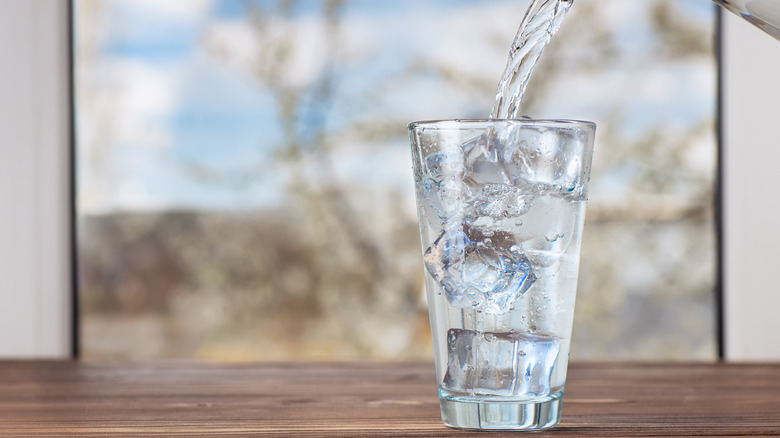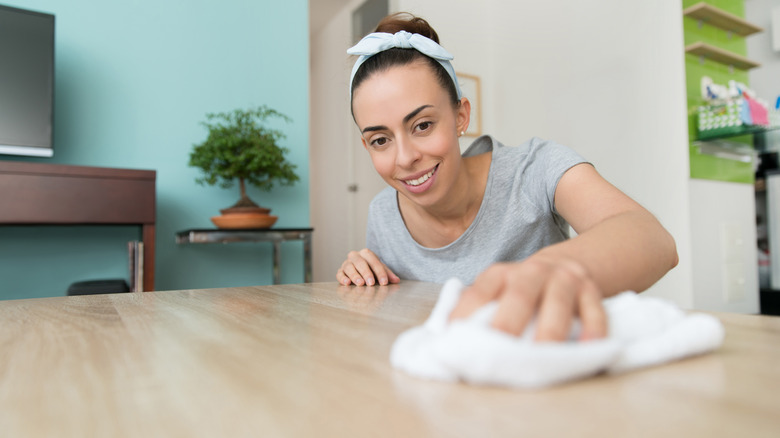The Bathroom Staple That'll Eliminate Watermarks On Your Furniture
Ah, the joys of living with roommates. They ignore your request to keep the toilet lid closed, insist on leaving dirty dishes in the sink overnight, and refuse to place a coaster under their sweaty beverages. You may be able to tolerate the first two, but the last grievance leaves a mark — in more ways than one. Water stains on wood furniture are no laughing matter, even if the pieces aren't valuable antiques. Fortunately, you don't need to spend a ton of time or money erasing the annoying white circles from your table. Spare your wallet and any potential roommate drama by simply using toothpaste to eliminate watermarks on your furniture.
Spotting opaque rings is always a disheartening moment no matter how hard your roommates try to convince you they're merely the result of a great night filled with raised glasses and spirited conversations. White circles indicate that moisture has soaked into the top layer of your furniture's wood finish. It can happen when cold or hot dishes are placed on wood surfaces, causing condensation to penetrate into the wax finish. If you notice white watermarks, rest easy, the damage is not as bad as it could be. It's when the stains are black that you have a much bigger issue on hand. Dark-colored watermarks mean the moisture has seeped beyond the protective layer and has affected the wood itself. In that case, you may be forced to refinish the piece or talk to a professional.
How to use toothpaste to eliminate watermarks on your furniture
Start by grabbing a tube of traditional white toothpaste — do not use gel or whitening types — and squeeze a liberal amount on a clean, soft rag. Next, gently rub a small, discreet corner of the stain to test how your furniture will react to the toothpaste. If you don't observe any damage or further discoloration to the wood, continue to rub the toothpaste on all of the white rings. Massage the toothpaste into the wood in the same direction as the grain without being too aggressive.
You should see the white circles lighten and eventually disappear as you progress; however, if you don't notice a significant change, it may be time to switch from the rag to a soft-bristled toothbrush. If you opt for this method, scrub lightly and cap the brushing at no more than a minute. Toothpaste acts as a mild abrasive to buff out the watermarks; consequently, you shouldn't have to scour continuously for long periods of time in order to see results. Once the marks are gone, wipe away any residual toothpaste with a clean cloth or paper towel, then apply a wood polish to make the surface shine.
To erase tougher milk-colored watermarks, increase toothpaste's abrasive powers by mixing it with some baking soda. Use a 50/50 mixture and apply exclusively to the white rings to prevent the toothpaste/baking soda stain remover from distressing non-affected areas. Repeat the process if necessary.
Tips to consider when using toothpaste on watermarks
Whether removing stains from carpets, clothing, or furniture, timing is of the essence, and white water rings are no exception. When using toothpaste to erase unsightly watermarks, it's important to act fast because the longer you allow the moisture to sit, the tougher it will be to completely remove the cloudy rings. As long as you treat the water circles when they are milky or opaque, the toothpaste method should — at the very least — fade the marks so they are less noticeable. Once the area is completely dry, treat the wood with lemon oil as an added line of defense. The natural substance acts as a cleaner, stain remover, and conditioner on wood surfaces. It also protects wood from moisture and prevents it from drying out and cracking.
Finally, since toothpaste is an ideal eraser for watermarks that haven't permanently settled into the wood, you can enhance its effectiveness by applying thick, clean towels on water rings before buffing. Doing so will ensure you have extracted as much of the moisture from the wood as possible. This will maximize toothpaste's alkaline properties and steadily lift water from the wood's pores to the furniture's surface where it can be rubbed away.

